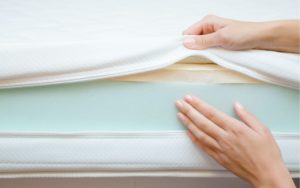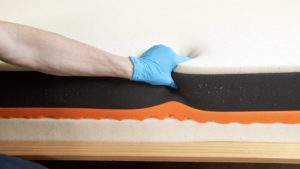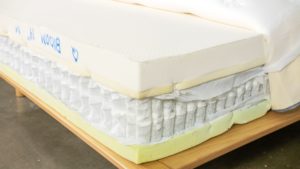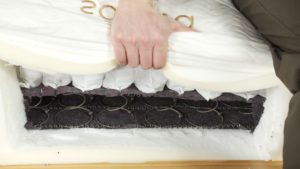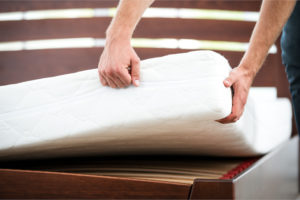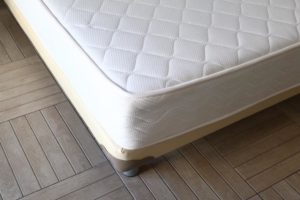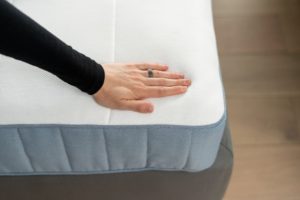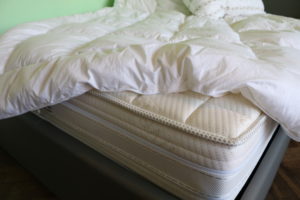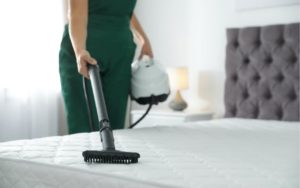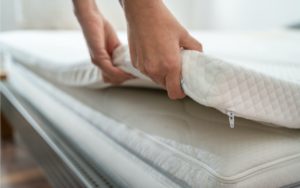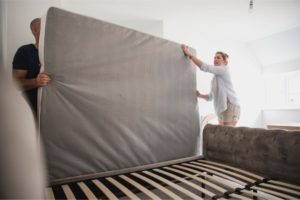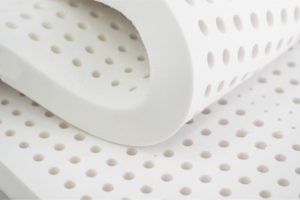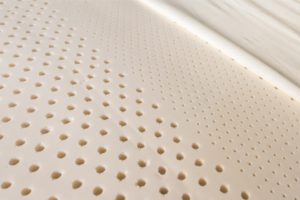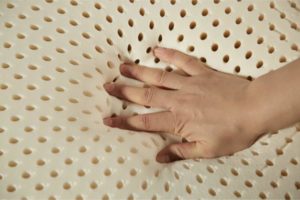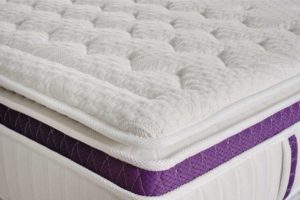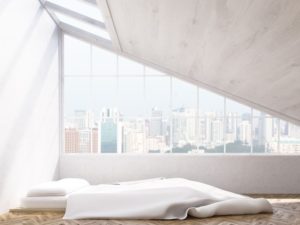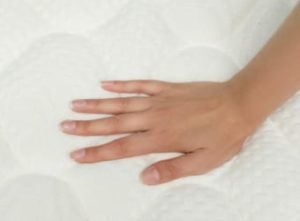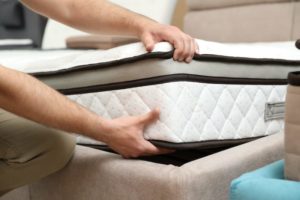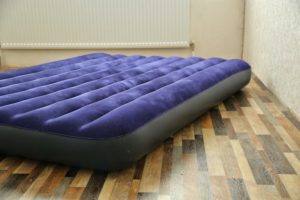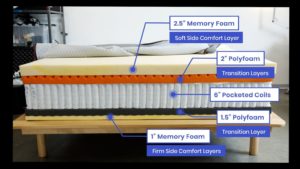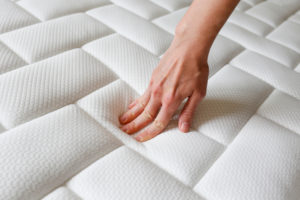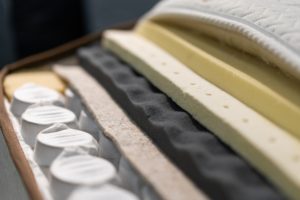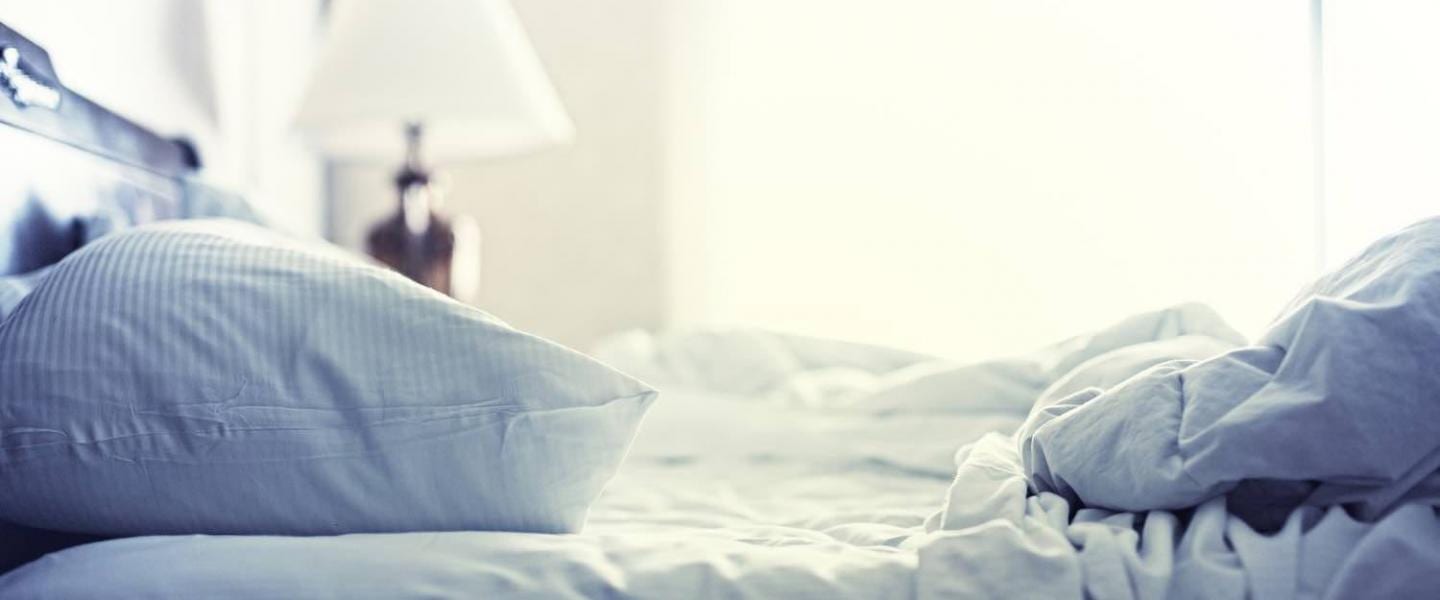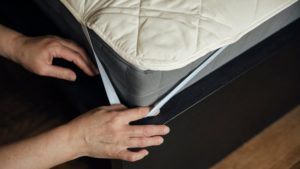When you buy through our links, we may earn a commission. Products or services may be offered by an affiliated entity. Learn more.
Mattress Firmness
Firmness plays a large role in how a mattress performs for different types of sleepers. The right firmness level can promote proper spinal alignment while cushioning sensitive areas of the body. However, a bed that is too soft or too firm can lead to strain and/or discomfort over time.
To help you understand how mattress firmness impacts sleep, we’ll outline the basic characteristics of each firmness level. Then, we’ll examine how they perform for different sleep styles and body types so that you can identify the best firmness range for your needs.
What Is Mattress Firmness?
Firmness refers to how soft or hard a mattress feels. While each manufacturer may use its own method to measure and describe firmness, we use a standard 10-point scale. Softer mattresses fall on the lower end, while firmer surfaces are on the higher end.
Factors such as materials and construction largely determine how firm a mattress feels. Most models consist of a comfort system layered over a support core. The comfort system is generally designed to cushion pressure points, like the hips and shoulders. Materials such as polyfoam, memory foam, latex, and fiber are common. Thicker comfort systems made of more conforming materials tend to give the mattress a softer feel, while thinner layers made of less malleable materials contribute to a firmer surface.
A transition layer may act as a buffer between the comfort system and the support core. This component can deepen the contouring and affect the perceived firmness. The support core is intended to reinforce the bed and keep the sleeper from sinking too far into the mattress. It is crucial to providing even support and keeping the spine in a more neutral position.
While consumers often confuse them, support and firmness are two separate traits. The firmness is linked mainly to the comfort layer, while the support is determined primarily by the mattress core. This means a mattress can simultaneously be soft and supportive or firm and unsupportive.
No one firmness level performs optimally for all sleepers. Factors such as weight, body type, and preferred sleep position all influence what is comfortable and supportive for you.
Additionally, firmness is not the only performance factor to consider when choosing a mattress. Other variables, such as durability, temperature neutrality, and responsiveness, can also influence overall comfort.
Let us help you find the perfect bed
Answer a few questions to find the right mattress for your unique needs
Mattress Firmness Scale
Since there is no universally accepted measurement for mattress firmness, each manufacturer may use its own system. However, a 10-point scale is common. Our system can give you a clearer idea of how a mattress may feel and how the firmness compares to other models.
| Firmness Level | Feel | Description |
|---|---|---|
| 1 | Extra Soft | Extra soft models sink significantly and conform closely to the sleeper’s body. |
| 2-3 | Soft | Soft surfaces sink and conform considerably. |
| 4 | Medium Soft | Medium soft mattresses sink some and conform relatively closely. |
| 5 | Medium | Medium mattresses sink less, though they still conform noticeably. |
| 6 | Medium Firm | Medium firm surfaces do not sink much, but they conform moderately. |
| 7-8 | Firm | Firm mattresses have virtually no sinkage and minimal conforming. |
| 9-10 | Extra Firm | Extra firm beds have no perceptible sinkage and virtually no conforming. |
Models are available to suit almost any firmness preference, but most rate around 5 or 6. To help illuminate the differences between these options, we’ll take a closer look at how each rating performs.
Extra Soft to Soft (1-3 out of 10)
Mattresses that rate between 1 and 3 are quite soft. They may also be classified as plush.
- Support: Softer beds are often comfortable for side sleepers who weigh under 130 pounds. However, heavier individuals and/or those who prefer other positions may sink in too deeply, jeopardizing their spinal alignment.
- Conforming: Soft mattresses conform closely to the body, which can help relieve pressure and provide a hugging sensation. While sleepers with sharp pressure points tend to enjoy this, others may find it claustrophobic.
- Temperature Neutrality: Because softer beds contour closely to the body, they also frequently trap heat.
- Durability: Softer mattresses are constructed using plush materials that often deteriorate faster. Therefore, models in this range may have a shorter lifespan than those with firmer materials.
- Pricing: Soft and extra soft mattresses usually feature thick comfort layers composed of materials that cradle the body, such as memory foam or latex. This can lead to a higher price-point.
- Popularity: Extra soft mattresses are not very popular, so they might be difficult to find. However, soft options are more widely available.
Medium Soft to Medium Firm (4-6 out of 10)
Mattresses that rate between 4 and 6 on the firmness scale fall into the average range that most individuals prefer. They have broad appeal across weight groups, and they may be especially appropriate for partners with different position preferences and/or body types.
- Support: Medium soft to medium firm mattresses offer moderate support with less sinkage than softer options. Sleepers who weigh between 130 and 230 pounds usually enjoy a good balance of contouring and support.
- Conforming: Mattresses in this firmness range often have considerable comfort systems that cradle the body to relieve pressure.
- Temperature Neutrality: Since medium soft to medium firm mattresses do not hug the body as closely as softer models, they often do not trap as much heat.
- Durability: These mattresses typically use sturdier materials that may better resist sagging or premature deterioration. As a result, medium soft to medium firm mattresses tend to last longer than softer models.
- Pricing: Mattresses in this category usually have a less substantial comfort system, which can lower the cost. The popularity of this firmness level can also make the pricing more competitive.
- Popularity: Medium soft to medium firm mattresses are very popular. Most manufacturers offer models in this range.
Firm to Extra Firm (7-10 out of 10)
Mattresses that rate between 7 and 10 provide a relatively even plane and a sturdy feel.
- Support: Firm to extra firm beds tend to offer exceptional support for sleepers who weigh over 230 pounds. Stomach sleepers may also prefer a firmer option to limit sinking in the midsection and promote proper spinal alignment.
- Conforming: Models in this range generally have thinner comfort layers that do not contour closely. Some side sleepers, especially those who weigh under 230 pounds, may experience pressure buildup around their hips and shoulders.
- Temperature Neutrality: Because firm and extra firm beds do not allow much sinkage, they are less likely to trap heat. Air can flow relatively freely around the body, allowing warmth to dissipate.
- Durability: Mattresses in this firmness range generally use highly durable materials, which often allow these beds to last longer than softer options.
- Pricing: Firm and extra firm mattresses tend to avoid using extra materials for padding. This can often make them less expensive than softer options with thicker comfort systems.
- Popularity: Firm mattresses are fairly popular and available through many retailers, though extra firm models may be more difficult to find.
How to Choose the Right Firmness Level
Determining which firmness level is right for you can be challenging. Factors such as your body type and your preferred sleep position impact how the bed performs, and no single firmness level is ideal for all sleepers.
While most sleepers prefer firmness levels ranging from 4 to 7, your preferred firmness is dependent on personal factors. To help you assess your optimal range, we’ll discuss key contributing aspects.
Body Weight and Firmness Levels
Your body type may determine which firmness you’re likely to find most comfortable.
Because each individual applies a different amount of pressure to the sleep surface based on their weight, the same mattress is likely to feel softer to a heavier person and firmer to a lighter person. While each person has unique preferences, understanding the role weight plays in the sleep experience can help you decide what’s best for you.
| Weight Range | Typical Firmness Preference | Recommended Firmness Levels |
|---|---|---|
| Less than 130 lbs. | Sleepers in this weight category usually favor softer, close-conforming mattresses. |
|
| 130 to 230 lbs. | Sleepers in this weight category typically prefer a gently conforming surface with slightly firmer support. |
|
| More than 230 lbs. | Sleepers in this weight category tend to prefer firmer surfaces that do not conform as closely for better spinal support. |
|
Across weight groups, sleepers usually prefer a mattress that balances contouring and support to ease pressure while promoting good posture. To achieve this, sleepers who weigh less usually need a softer mattress, while those who weigh more require firmer support.
Weight distribution can also influence firmness preferences. For instance, the weight of a tall person is spread over a much larger surface area than that of a short individual. Therefore, the same mattress may feel firmer to a tall sleeper than it would to a short sleeper of the same weight.
Sleeping Position and Firmness Levels
Your sleep position determines which parts of your body make contact with the mattress and to what extent. A firmness level that provides the right mixture of support and contouring to accommodate your preferred position is essential to preventing discomfort.
| Sleeping Position | Recommended Firmness for Sleepers Under 130 lbs. | Recommended Firmness for Sleepers Between 130 and 230 lbs. | Recommended Firmness for Sleepers Over 230lbs. |
|---|---|---|---|
| Side Sleepers | Soft (3) to Medium (5) | Medium Soft (4) to Medium (5) | Medium Firm (6) to Firm (7) |
| Back Sleepers | Soft (3) to Medium (5) | Medium (5) to Firm (7) | Firm (7, 8) to Extra Firm (9) |
| Stomach Sleepers | Medium Soft (4) to Medium Firm (6) | Medium (5) to Firm (7) | Firm (7, 8) to Extra Firm (9) |
| Combination Sleepers | Soft (3) to Medium (5) | Medium Soft (4) to Medium Firm (6) | Firm (7, 8) |
Side Sleeping: Side sleepers place considerable pressure on their hips and shoulders. Mattresses that are too firm can push the spine out of alignment and cause pressure buildup in these areas. However, a sleep surface that is too soft can lead to poor posture as a result of excessive sagging. Sleepers who prefer sleeping on their sides usually benefit from plusher surfaces that cushion or cradle the body. Depending on their weight, many side sleepers enjoy firmness levels ranging from soft (2) to firm (7).
Back Sleeping: Back sleepers generally require a slightly firmer mattress that resists sagging in the midsection. Subtle cradling can keep the spine in a more neutral position while supporting the lumbar region. Mattresses that are too soft or too firm could put pressure on the lower back. Back sleepers tend to prefer firmness levels ranging from soft (3) to firm (8).
Stomach Sleeping: Stomach sleeping is inadvisable for most individuals due to the potential for strain. A mattress with inadequate support can allow the midsection to sag, causing an unnatural arch in the lower back that may result in pain. Because of this, stomach sleepers usually prefer firmer models than side or back sleepers. A rating between soft (3) and firm (8) may be suitable depending on the sleeper’s weight.
Combination Sleeping: Combination sleepers switch between multiple sleep positions, even within a single night. These sleepers may have a tough time choosing their optimal firmness level because their needs change with each position. For this reason, moderate firmness levels tend to be best, with most combination sleepers opting for beds ranging from soft (3) to firm (8).
Sex and Firmness Levels
Two main factors influence how a bed performs for sex: responsiveness and sinkage. Mattresses that are responsive and bouncy make movement easier, while those that absorb motion can make it more challenging. Additionally, a surface that sinks deeply may inhibit movement. That said, contouring can also enhance traction. While responsiveness and contouring are determined largely by materials, couples often find that softer models provide extra traction but are more difficult to move on.
Some other factors to consider include edge support and noise potential. Mattresses with stronger perimeters let couples use the entire surface, and quiet models allow greater discretion. Firmer mattresses frequently have sturdier edges, though soft models may include reinforced perimeters to make the full surface usable. Noise level is a result of a mattress’ materials and construction, but the ample comfort system of some soft mattresses could help muffle sounds.
| Firmness Range | Characteristics | Rating for Sex |
|---|---|---|
| 1-3 out of 10 | Beds in this category conform closely and sink deeply, which can make movement more difficult. | Poor to Fair |
| 4-6 out of 10 | Medium soft to medium firm mattresses typically have enough support for sexual activity while also contouring to provide traction and remain comfortable. | Good to Very Good |
| 7-10 out of 10 | Mattresses in this category may be too firm to be comfortable, though they often enhance movement by preventing sinkage. | Fair to Good |
Mattresses ranging from medium soft to medium firm typically perform the best for sex because they balance support and contouring. Firmer surfaces might be less comfortable, while softer models could inhibit movement.
Pillow Loft and Firmness Levels
The best pillows work with your mattress to support your neck and spine. Choosing an option that is compatible with your mattress firmness can help prevent neck or shoulder pain and ensure you are fully supported from head to toe.
The greatest factor that impacts how your pillow works with your mattress firmness is the loft. High-loft pillows are thicker, while low-loft pillows are thinner. Shoppers should note that material composition can also impact loft since some materials sink more considerably than others. Pillows made of down, down alternative, or polyester are likely to compress more significantly than those made of sturdier materials, such as latex or memory foam.
High-loft pillows tend to work best with firmer beds, while lower-loft pillows are better suited to softer mattresses. Since sleepers tend to sink further into softer beds, they require less pillow loft to keep their neck in a neutral position. Meanwhile, sleepers on firmer mattresses may need a thicker pillow to adequately cushion and support the neck.
| Firmness Range | Compatibility with Low-Loft Pillows (under 3”) | Compatibility with Medium-Loft Pillows (3-5”) | Compatibility with High-Loft Pillows (over 5”) |
|---|---|---|---|
| 1-3 out of 10 | Good to Very Good | Fair to Good | Poor |
| 4-6 out of 10 | Fair to Good | Good to Very Good | Fair to Good |
| 7-10 out of 10 | Poor | Fair to Good | Good to Very Good |
Other Factors to Consider
While firmness can greatly impact how your bed feels and performs, there are also many other factors to consider when selecting a mattress.
Partner’s Preferences
When selecting a mattress to share, it is important to consider the needs and preferences of both partners. Many couples compromise by choosing a sleep surface between their preferred firmness levels. However, if your partner’s body type and/or position preferences are entirely different from yours, it may be worth considering a split mattress.
Temperature Neutrality
Overheating is a common problem that can disrupt quality rest. Softer mattresses typically conform closely to the sleeper’s body and frequently use materials prone to trapping heat, such as memory foam. Firmer mattresses with minimal sinkage usually sleep cooler by allowing more air circulation around the body.
Durability
Softer mattresses with plush materials generally wear out faster than firmer options. Thick, soft comfort layers may sag or develop lasting indentations earlier, which can reduce support and lead to discomfort.
Price
Firmer beds with thinner comfort layers tend to cost less because they require less material to produce. However, other factors, such as the use of specialized components or unique designs, can also impact price.
Mattress Weight
Heavier mattresses can be more difficult to set up or move. Softer models tend to be thicker and heavier, particularly if they use latex or coil layers.
Odor Potential
Most new mattresses made from synthetic material have a distinct chemical odor that usually dissipates within a few days. This is the result of off-gassing, during which newly manufactured mattresses release volatile organic compounds (VOCs). Certain materials, such as foam, are more susceptible to off-gassing. Since many softer mattresses incorporate layers of foam, they may also come with a stronger odor.
Adjustable, Flippable, and Dual-Firmness Mattresses
While most mattresses sold today have one fixed firmness rating, some beds come with multiple built-in firmness options.
Adjustable Mattresses: Adjustable mattresses offer a set range of firmness levels. These models are typically airbeds with chambers that can be emptied or filled using manual controls, a remote, or an app. Since adjustments are usually easy, a sleeper can change the firmness as needed throughout the night. Though these mattresses are usually pricey, they can be useful for sleepers with fluctuating firmness preferences.
Flippable Mattresses: Flippable mattresses use two comfort layers over a shared support core, so either side can be used as the sleep surface. Many flippable models have two separate firmness levels, allowing users to flip the mattress over for a different feel.
Dual-Firmness Mattresses: Dual-firmness mattresses are a great option for partners with different needs and preferences. The surface is split in two so that each sleeper can enjoy a different firmness level. Shoppers should note, however, that most of these beds are only available in queen size and larger.
What Determines the Firmness of a Mattress?
The type of mattress can influence the sleep surface’s overall firmness. There are four common mattress types, which are defined by their materials. Understanding the general characteristics of these options can help you anticipate how each is likely to feel and perform. However, there are variations between models of similar constructions based on their unique designs and materials.
Innerspring: Innersprings were once the most common type of mattress. They use a coil support core, which is typically made of steel. Though factors such as the coil pattern and gauge impact how a model feels and performs, these beds are generally known for being bouncy, breathable, and supportive. Most innersprings do not have thick comfort layers, meaning they often have firmer feels.
Hybrid: Hybrid mattresses pair the coil support core of an innerspring with the thicker comfort layers of a foam or latex model. These beds typically provide a durable, responsive surface while also contouring to relieve pressure. Hybrids come in a wide variety of firmness options, so most shoppers should be able to find a model in their preferred range.
Foam: Foam mattresses consist of polyfoam, memory foam, and/or latex. They tend to conform closely to the body and provide ample pressure relief. All-foam models are often softer than other mattress types, though exceptionally firm options are also available.
Latex: Latex is a responsive material that spreads out the force of the sleeper’s body over a wider area, relieving pressure while limiting sinkage. Beds made of latex are also known for their exceptional durability. Firmness varies a great deal between models, but Talalay latex is usually softer than Dunlop latex.
Is Firmness the Same as Support?
Though firmness and support are closely related, they are not the same thing. Firmness refers to how soft or hard the mattress feels, while support refers to whether the mattress promotes proper spinal alignment. The comfort system is primarily responsible for firmness, and the core plays a bigger role in support. Firmness does not determine support, but the two can influence each other.

Still have questions? Ask our community!
Join our Sleep Care Community — a trusted hub of sleep health professionals, product specialists, and people just like you. Whether you need expert sleep advice for your insomnia or you’re searching for the perfect mattress, we’ve got you covered. Get personalized guidance from the experts who know sleep best.

